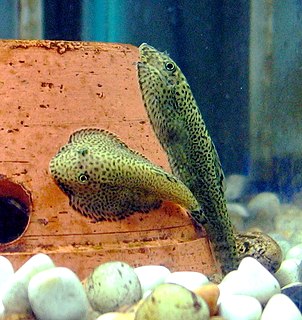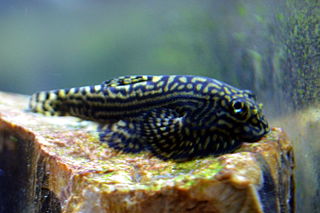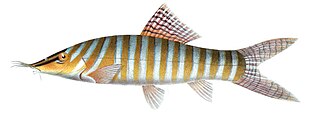
Cobitidae, also known as the True loaches, is a family of Old World freshwater fish. They occur throughout Eurasia and in Morocco, and inhabit riverine ecosystems. Today, most "loaches" are placed in other families. The family includes about 260 described species. New species are being described regularly.

The hillstream loaches or river loaches are a family, the Balitoridae, of small fish from South, Southeast and East Asia. The family includes about 202 species. They are sometimes sold as "lizardfish" or "flossensaugers". Many of the species are popular for aquaria, species in the genus Sewellia are most commonly sold in the aquaria trade. They have a number of similarities with the Cobitidae, their sibling family of "loaches", such as multiple barbels around the mouth. They should not be confused with the loricariids, which look similar but are a family of catfish.

Acantopsis is a genus of freshwater fishes, commonly known as horseface loaches or banana-root fishes, in the family Cobitidae. Fishes of the genus Acantopsis inhabit sandy riverbeds throughout Southeast Asia. The common horseface loach, A. rungthipae, is popular in the aquarium trade.

Yasuhikotakia is a genus of botiid loaches, many which are popular aquarium fish. It is named in honor of Japanese collector/researcher Dr. Yasuhiko Taki. This genus has been separated from the genus Botia in the paper by Maurice Kottelat in 2004.

Misgurnus is a genus of true loaches found in Europe and Asia. The origin of the name Misgurnus comes from the Greek word miseo and the Turkish gür (loud), a name given to them due to their habit of becoming very active during barometric pressure changes that occur during thunderstorms. The common names, weather loach or weatherfish, also derive from this behavior. Some species of misgurnus are eaten, mostly in Asia, and are also sold as pets in the aquarium trade.

Hemimyzon is a genus of ray-finned fish in the family Balitoridae.

Schistura is a genus of fish in the stone loach family Nemacheilidae native to the streams and rivers of the southern and eastern Asia. Some of these species are troglobitic.

Beaufortia is a genus of gastromyzontid loaches from China and mainland Southeast Asia.

Gastromyzon is a genus of gastromyzontid loaches native to Borneo.
Gastromyzon megalepis is a species of ray-finned fish in the genus Gastromyzon.

Loaches are fish of the superfamily Cobitoidea. They are freshwater, benthic (bottom-dwelling) fish found in rivers and creeks throughout Eurasia and northern Africa. Loaches are among the most diverse groups of fish; the 1249 known species of Cobitoidea comprise about 107 genera divided among 9 families.
Barbucca is a genus of loaches native to Southeast Asia. It is currently the only genus in its family.

Hypergastromyzon is a small genus of loaches endemic to the island of Borneo in Southeast Asia.

Sewellia is a genus of fish in the family Balitoridae found in Laos and Vietnam. According to Roberts (1998) a possible defining characteristic of the genus Sewellia is their posterior pelvic valve is highly complex and different from other rheophilic loaches, their posterior pelvic valve involves the overlapping of the second to last ventrally exposed rays. Adapted to high velocity streams Sewellia have depressed body shapes that are laterally expanded thus increasing their hydrodynamical properties and allowing them to better stay attached to rocks in swift current. Sewellia also have paired fins with a single simple ray and numerous branched rays allowing them to grip rocks in swift current.
Kottelatlimia is a genus of loaches found in Southeast Asia.
Lepidocephalus is a genus of loaches native to rivers in the Southeast Asian countries of Indonesia, Malaysia and Thailand. Members of this genus are known as "spirit loaches". They resemble the related kuhli loaches and Lepidocephalichthys loaches, but are more robust and generally found deep in large rivers. With little or no light in their habitat, their eyes and pigmentation are reduced to various extent. One species, L. spectrum, completely lacks pigment and eyes, similar to cavefish. They are generally poorly known, but based on the relatively few scientific museum specimens they can reach up to 8 cm (3.1 in) in standard length.

Serpenticobitis, popularly known as serpent loaches, is a small genus of loaches found in the Mekong River Basin in Southeast Asia. It is the only genus in the family Serpenticobitidae.

Syncrossus is a genus of six loaches, many of which are popular in the aquarium fish trade. They are primarily found in Southeast Asia, but S. berdmorei also occurs marginally outside this region in far northeastern India. It is one of eight genera in its family.
The Nemacheilidae, or stone loaches, are a family of cypriniform fishes that inhabit stream environments, mostly in Eurasia, with one genus, Afronemacheilus found in Africa. The family includes about 630 species.

The Gastromyzontidae are a family of loaches native to China and Southeast Asia, where typically found in streams and rivers with a fast current. The family includes about 137 species in eighteen genera. This family was resurrected by M. Kottelat in his review and revision of the loaches in 2012. They are commonly called hillstream loaches.













